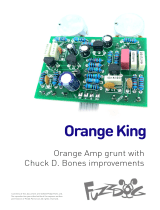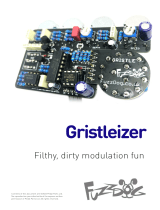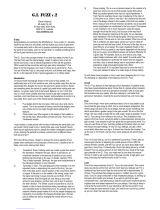Page is loading ...

Exploder
Massive Fuzz-Face style Fuzz
without the Fuzz-Face Fuss
Contents of this document are ©2020 Pedal Parts Ltd.
No reproduction permitted without the express written
permission of Pedal Parts Ltd. All rights reserved.

Important notes
If you’re using any of our footswitch daughterboards,
DOWNLOAD THE DAUGHTERBOARD DOCUMENT
•Download and read the appropriate build document for the daughterboard
as well as this one BEFORE you start.
•DO NOT solder the supplied Current Limiting Resistor (CLR) to the main
circuit board even if there is a place for it. This should be soldered to the
footswitch daughterboard.
POWER SUPPLY
Unless otherwise stated in this document this circuit is designed to be
powered with 9V DC.
COMPONENT SPECS
Unless otherwise stated in this document:
•Resistors should be 0.25W. You can use those with higher ratings but
check the physical size of them.
•Electrolytics caps should be at least 25V for 9V circuits, 35V for 18V
circuits. Again, check physical size if using higher ratings.
LAYOUT CONVENTIONS
Unless otherwise stated in this document, the following are used:
•Electrolytic capacitors:
Long leg (anode) to square pad.
•Diodes/LEDs:
Striped leg (cathode) to square pad. Short leg to square pad for LEDs.
•ICs:
Square pad indicates pin 1.

Schematic + BOM
R1 1M
R2 1M
R3 4K7
R4 1K
R5 470R
R6 470R
R7 100K
R8 100K
R9 1K5
C1 1u elec
C2 1n
C3 47p
C4 100p
C5 68n
C6 1u elec
C7 22u elec
C8 100u elec
D1 1N4001
Q1 2N5457*
Q2-3 2N2222**
XFM1 42TL019
T1 4K7-10K trim
T2 100K trim***
BIAS A/B 10KB‡
VOL 100KA***
*Original uses PF5102. It makes no difference at all to the sound. Pads are provided
for through-hole or SMT FETs. The SMT version of 2N5457 is MMBF5457.
**Original uses 2N497. Try any low gain BJT transistors in here.
Pinout on the PCB is E B C with emitter indicated by the tab.
***Use a trimmer OR the volume pot. Not both.
‡There are two sets of pads for the BIAS pot. Use one or the other, not both.
BIAS-A is ideal if you’re making a single knob version.
BIAS-B positions the pot side by side with the optional VOL pot.
Other transformers may work but we’ve only tried it with this one.
Note: the 42TL series has a much smaller footprint than 42TM, so don’t mix them up.


The power and signal pads on the PCB conform
to the FuzzDog Direct Connection format, so can
be paired with the appropriate daughterboard for
quick and easy offboard wiring. Check the
separate daughterboard document for details.
Be very careful when soldering the transistors,
diodes and LED. They’re very sensitive to heat.
You should use some kind of heat sink (crocodile
clip or reverse action tweezers) on each leg as
you solder them. Keep exposure to heat to a
minimum (under 2 seconds). Same goes for the
ICs if you aren’t using sockets.
Snap the small metal tag off the pots so they can
be mounted flush in the box.
There are extra pads for the trimmers to
accommodate different types. The pads are
linked within the structure of the PCB as shown
in red above. When placing your trimmer(s) you
just need to ensure that one leg goes into each
column.
CONTROL COMBINATIONS
For a single knob version:
Pot in BIAS-A, volume set by T2
VOL and BIAS-B empty
For a master volume, two knob version:
Pots in BIAS-B and VOL
BIAS-A and T2 empty
No jumpers required on any configuration.
TRIMMER SETTINGS
Once you’re all soldered up and ready to go you
need to set your trimmers. If you’re using an
external volume pot ignore T2.
To set the bias control, position your bias pot at
12 o’clock. With a multimeter set to DC voltage
attached to ground and the collector of Q3,
adjust T2 until you get a reading of around half
your supply voltage, so 4.5V for a 9V supply.
A little either way is fine. That will give you
perfect bias at 12 o’clock, and a good range in
both directions.
If you’re not using an external pot for volume, set
your bias pot to where you think you’ll likely use
it and adjust T2 until you get your prefered
output volume. This will drop or increase when
adjusting the bias pot.
PCB layout ©2020 Pedal Parts Ltd.

Test the board!
Check the relevant daughterboard document for more
info before you undertake this stage.
UNDER NO CIRCUMSTANCES will troubleshooting help
be offered if you have skipped this stage. No exceptions.
Once you’ve finished the circuit it makes sense to test is before starting on the switch and LED
wiring. It’ll cut down troubleshooting time in the long run. If the circuit works at this stage, but it
doesn’t once you wire up the switch - guess what? You’ve probably made a mistake with the switch.
Solder some nice, long lengths of wire to the board connections for 9V, GND, IN and OUT. Connect
IN and OUT to the jacks as shown. Connect all the GNDs together (twist them up and add a small
amount of solder to tack it). Connect the battery + lead to the 9V wire, same method. Plug in. Go!
If you’re using a ribbon cable you can tack the wires to the ends of that. It’s a lot easier to take them
off there than it is do desolder wires from the PCB pads.
If it works, carry on and do your switch wiring. If not... aw man. At least you know the problem is
with the circuit. Find out why, get it working, THEN worry about the switch etc.
Your completed circuit board
including pots

Wiring shown above will disconnect the battery when you remove the jack plug
from the input, and also when a DC plug is inserted.
The Board GND connections don’t all have to directly attach to the board. You
can run a couple of wires from the DC connector, one to the board, another to
the IN jack, then daisy chain that over to the OUT jack.
It doesn’t matter how they all connect, as long as they do.
This circuit is standard, Negative GND. Your power supply should be Tip
Negative / Sleeve Positive. That’s the same as your standard pedals (Boss etc),
and you can safely daisy-chain your supply to this pedal.
L
E
D
BOARD
OUT
BOARD
9V
BOARD
GND
BOARD
GND
BOARD
GND
BOARD
INPUT
BATTERY
+
IN
OUT
L
E
D
BOARD
GND
BOARD
9V
+
Wire it up (if using a daughterboard please refer to the relevant document)

This template is a rough guide only. You should ensure correct marking of your
enclosure before drilling. You use this template at your own risk.
Pedal Parts Ltd can accept no responsibility for incorrect drilling of enclosures.
FuzzDog.co.uk
Drilling template
Hammond 1590B
60 x 111 x 31mm
It’s a good idea to drill the pot and
toggle switch holes 1mm bigger if
you’re board-mounting them.
Wiggle room = good!
Recommended drill sizes:
Pots 7mm
Jacks 10mm
Footswitch 12mm
DC Socket 12mm
Toggle switches 6mm
32mm
/











